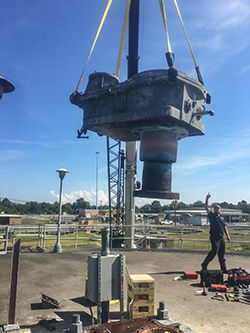for use in the tooth flank:
This determines the local wear in
each point of the tooth contact area on
the gear. At the suggestion of the authors,
this formula has been included
in VDI 2736 (Ref. 1). Another confirmation
of the formula’s effectiveness is
that Feulner (Ref. 2) derived the same
formula on the basis of measurements.
Determining the Progression
of Wear
The wear characteristics can be calculated
by implementing the formula
(Eq. 2) for local wear on the flank in a
gear contact analysis. This makes it possible
to define the shape of the abraded
tooth flank. Initially, this approach did
not provide any usable results, if the
wear — starting with a perfect tooth
form — was determined in a single calculation
step. The wear characteristics
must be calculated step by step because
the tooth form changes as it becomes
worn, and therefore the load distribution
moves across the meshing. Very
useful results can now be achieved by
running the calculation at a sufficient
number of small increments. The maximum
permitted wear
per iterative step must
be predefined, so that
the iterative progression
of wear can be
calculated. This predefined
value is critical
for achieving realistic
results. This recently
developed calculation
method has been used
to compare a range of
gears that have been
subjected to testing and then measured
in 3D.

figure 2 Diagram showing how wear rates are determined (pn and disk test).

Figure 3 Wear characteristics on a dry-running PBT gear, in accordance with measurement (Ref. 2) and in accordance with the calculation with and without an
iterative definition of the progression of wear.
Figure 3
shows this type of comparison
using a pairing where the plastic
(PBT) output gear is badly worn. The
difference between the arithmetical
forecasts, with and without iterative
calculation, clearly shows that the wear
characteristics along the flank without
iteration cannot be used and it displays
quite a different trend to the measured
progression. A maximum interval of
1 µm wear per iterative step has been
defined for the wear characteristics in a
forecast with iteration. In this case, 146
iterations were calculated (the calculation
took 2.5 min, using an Intel Core
i7-3770). The result showed a relatively
good match with the measurement.
Influence on Transmission
Error
As the tooth form can now be predicted
with reasonable accuracy, more detailed
analyses — for example, determining
the change in load distribution
or the increase in transmission error
due to wear — can be defined. Increasing
vibrations in the meshing over a
long period of time can reduce the endurance
limit. This is a recognized effect
of frosting and a cause of concern
wherever gears are used. For this reason,
being able to predict the progression
of transmission error in advance is
a very interesting result.
Initial verifications performed on
different pairs of gears have revealed
that transmission error has a tendency
to decrease in the first phase of wear
(“running-in phase”); however, as the
amount of wear increases, this error
also increases significantly to reach values
that are two to three times greater.
Figure 4
shows results calculated using
a steel/PBT gear pair (Figure 3).
When the tooth flank calculated by
wear iterations is verified with contact
analysis, it is visible that the “Peak-to-
Peak Transmission Error” (PPTE) is
much greater when the wear has alsoprogressed. Closer investigation of the
development of transmission error
over the operating time shows an initial
improvement in the transmission behavior.
It is generally accepted that gear
units which have been properly run
in have a better load capacity because
the load distribution has a tendency to
improve during the running-in period.
This “running-in effect” obviously also
applies to the transmission error.
However, as the wear increases,
the transmission error also increases
sharply until it reaches a plateau. The
fact that the transmission error does
not then continue to increase, but remains
at a specific, high level, can be
explained as follows: a certain level
of equilibrium is achieved where the
tooth thickness continues to decrease
but the tooth form no longer changes
very much. This is illustrated by the
worn flanks in Figure 4.


 Figure 1 Left:pin and disk test rig. Middle:"thrust washer" test rig. Right: gear testing apparatus.
Figure 1 Left:pin and disk test rig. Middle:"thrust washer" test rig. Right: gear testing apparatus.






 figure 2 Diagram showing how wear rates are determined (pn and disk test).
figure 2 Diagram showing how wear rates are determined (pn and disk test). Figure 3 Wear characteristics on a dry-running PBT gear, in accordance with measurement (Ref. 2) and in accordance with the calculation with and without an
iterative definition of the progression of wear.
Figure 3 Wear characteristics on a dry-running PBT gear, in accordance with measurement (Ref. 2) and in accordance with the calculation with and without an
iterative definition of the progression of wear.

 Figure 4 Left top: Progression of PPTE over the service life. Left bottom: Change in the transverse contact ratio. Right: Worn tooth flank in several steps up to 1000 h.
Figure 4 Left top: Progression of PPTE over the service life. Left bottom: Change in the transverse contact ratio. Right: Worn tooth flank in several steps up to 1000 h. Ph.D.Eng. Ulrich Kissling
studied machine engineering
at the Swiss Technical
University (ETH) in Zürich,
followed by a doctorate. He
is the founder (1998) and
CEO of the company KISSsoft
AG.
Ph.D.Eng. Ulrich Kissling
studied machine engineering
at the Swiss Technical
University (ETH) in Zürich,
followed by a doctorate. He
is the founder (1998) and
CEO of the company KISSsoft
AG. M.Eng. Sandro Hauri was
trained as a mechanical
engineer at the Swiss Federal
Institute of Technology in
Zurich (ETH) and specialized
in Robotics. He joined
KISSsoft AG after his studies
as a development engineer.
M.Eng. Sandro Hauri was
trained as a mechanical
engineer at the Swiss Federal
Institute of Technology in
Zurich (ETH) and specialized
in Robotics. He joined
KISSsoft AG after his studies
as a development engineer.